Addressing Cognitive Impairments in Hospice Patients
July 21, 2025
Enhancing Care for Patients with Cognitive Challenges at End of Life

Understanding and Managing Cognitive Decline in Hospice Settings
Cognitive impairments are prevalent among hospice patients, yet often remain under-recognized and undertreated. Recent studies reveal that more than half of hospice patients without a clinical diagnosis of cognitive impairment demonstrate significant deficits in key cognitive domains, including memory, reasoning, and verbal skills. This article explores the causes, assessment methods, management strategies, and implications of cognitive decline in hospice care, emphasizing the importance of tailored approaches to improve patient outcomes, decision-making capacity, and quality of life.
Prevalence and Hidden Nature of Cognitive Impairment in Hospice Patients
How common are cognitive deficits among hospice patients?
Research indicates that more than half of hospice patients—around 54%—show significant cognitive deficits even when they do not have obvious or diagnosed impairments. This means that a large proportion of individuals nearing the end of life may experience cognitive challenges that aren’t immediately apparent.
Do these deficits exist without clinical signs?
Indeed, many patients demonstrate impairments in verbal learning, memory, reasoning, and fluency without showing clear clinical symptoms or receiving a formal diagnosis. These hidden deficits suggest that cognitive impairment is more widespread than previously thought, especially in the hospice setting.
Why is routine cognitive screening important?
Because cognitive issues can be subtle and easily overlooked, healthcare practitioners play a vital role in observing potential signs during routine interactions. Using quick, reliable screening tools like the Mini-Cog, AD8, or QDRS—each taking less than 10 minutes—can help identify problems early.
Early assessment provides multiple benefits: if cognitive function appears normal, it reassures patients and families; if deficits are detected, targeted interventions can be implemented. This may include addressing reversible causes such as medication effects, infections, or metabolic issues, or planning for supportive care as cognitive decline progresses.
How are cognitive impairments evaluated?
Initial screening is typically performed by trained staff using brief assessments. When necessary, further testing—such as neuropsychological evaluations, neuroimaging, or biomarker analysis—can confirm the diagnosis.
How does cognitive status influence hospice care?
Assessment results inform care planning and decision-making, especially regarding eligibility for hospice services. For example, a FAST score of 7A or higher usually indicates advanced or end-stage dementia, qualifying the patient for hospice focused on comfort and quality of life.
What are common forms of severe cognitive impairment?
Common examples include Alzheimer's disease, Lewy body dementia, stroke, traumatic brain injury, and Parkinson’s disease, among others. These conditions involve extensive deficits in memory, reasoning, language, and judgment, often requiring continuous supervision and significantly impacting daily life.
Silent Yet Significant – Recognizing Cognitive Deficits Without Clinical Labels
How do cognitive deficits often go unnoticed without formal diagnosis?
Many patients in hospice care appear to function normally on the surface but may actually experience considerable cognitive challenges. Research indicates that over half (54%) of hospice patients without obvious cognitive impairment show significant deficits in areas such as verbal learning, memory, reasoning, and fluency. These impairments can exist silently, meaning they are not always evident through routine clinical impressions or everyday observations.
This under-recognition occurs partly because cognitive deterioration can be subtle early on or mistaken for normal aging. Without specific assessments, these deficits often remain hidden, leading clinicians and caregivers to overlook their presence. Recognizing that cognitive issues are more prevalent than previously thought emphasizes the importance of routine and targeted evaluations.
What signs do healthcare practitioners and caregivers observe?
Health professionals and family members who spend regular time with hospice patients are well-placed to notice early signs of cognitive decline. These signs include trouble recalling recent conversations or appointments, difficulty following instructions, hesitations in verbal communication, and challenges with decision-making or problem-solving.
Caregivers may observe behaviors such as inconsistent routines, increased confusion, or withdrawal from social interactions. Because many of these patients are considered cognitively 'normal' based on superficial assessments, attentive observation is crucial. Small behavioral shifts, especially when persistent or worsening, should prompt a more detailed evaluation.
How do unrecognized impairments affect care planning?
Unidentified cognitive deficits can profoundly impact care strategies. Patients with undetected impairments might struggle with making informed decisions about their treatment or advance directives. This can lead to misunderstandings, decreased autonomy, or suboptimal management of their comfort and safety.
Accurate assessment ensures caregivers and healthcare teams are aware of a patient's actual capacity. This understanding allows for tailored communication approaches, informed consent processes, and safety measures. Standardized, brief assessment tools like the Mini-Cog or QDRS, which can be completed in under 10 minutes, are vital in identifying these issues early.
Furthermore, evaluating cognition—particularly verbal abilities like reasoning and memory—can inform decisions about further testing and interventions. Recognizing these deficits helps in planning appropriate supportive measures, from engaging caregivers in decision-making to adjusting treatment approaches, ultimately improving quality of life in hospice settings.
| Aspect | Details | Additional Notes |
|---|---|---|
| Prevalence | Over 50% of hospice patients show deficits without obvious signs | Highlighting need for routine screening |
| Signs | Memory troubles, disorientation, verbal communication issues | Early indicators to observe |
| Impact on Care | Affects decision-making, safety, and consent | Proper assessment leads to better tailored care |
| Assessment Tools | Mini-Cog, QDRS, AD8 | Efficient, quick methods for initial screening |
| Outcomes | Better safety, tailored support, improved quality of life | Supports patient dignity and independence |
Understanding and recognizing cognitive impairments that often go unnoticed is crucial in providing comprehensive hospice care. Early detection and appropriate assessment play essential roles in ensuring patients’ needs are effectively addressed and their dignity maintained.
The Critical Role of Assessment in Cognitive Health Evaluation
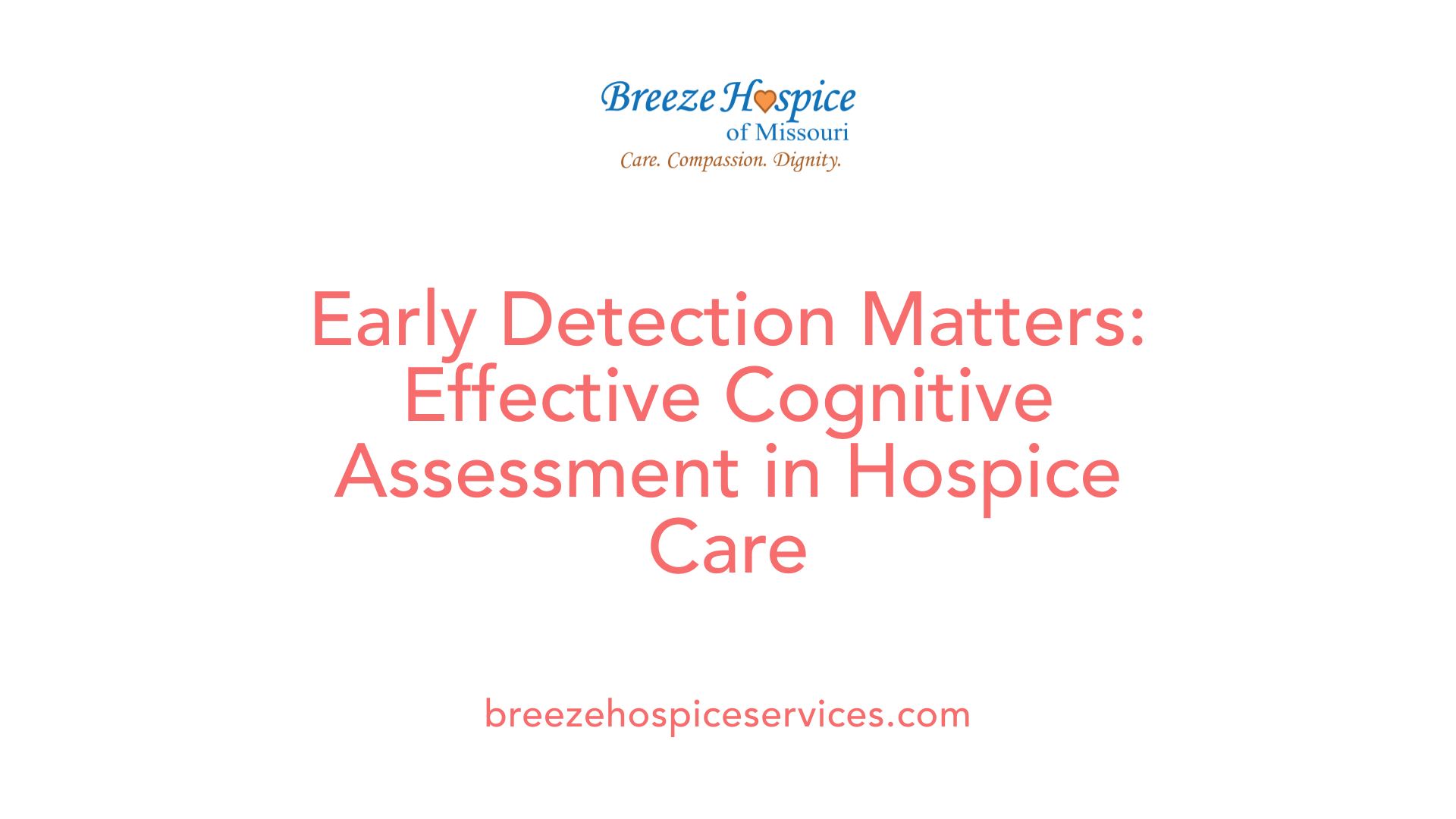
What assessment tools are used to evaluate cognitive function in hospice patients?
To effectively evaluate cognition in hospice patients, healthcare providers utilize a variety of assessment tools. Brief screening instruments such as the Mini-Cog, AD8, and QDRS are popular choices because they can be completed quickly—typically in less than 10 minutes—and require minimal training. These tools help identify patients who may have undiagnosed cognitive impairments, even when they appear cognitively normal.
For more detailed understanding, neuropsychological testing may be employed. These comprehensive evaluations involve specialists such as neuropsychologists or neurologists and can clarify the extent and nature of cognitive deficits. This deeper assessment is particularly useful if initial screenings raise concerns or if symptoms are complex.
Regular assessments are vital during routine hospice visits or when caregivers and family members observe behavioral or functional changes. Tracking these changes over time enables clinicians to tailor care plans, address safety concerns, and determine the need for further diagnostic procedures.
The results from these evaluations inform key decisions, including medication management, safety protocols, and the necessity for additional testing. Early and consistent assessment ensures that subtle impairments are not overlooked and that patients receive appropriate support and intervention.
The Use of the FAST Score in Hospice and Dementia Care
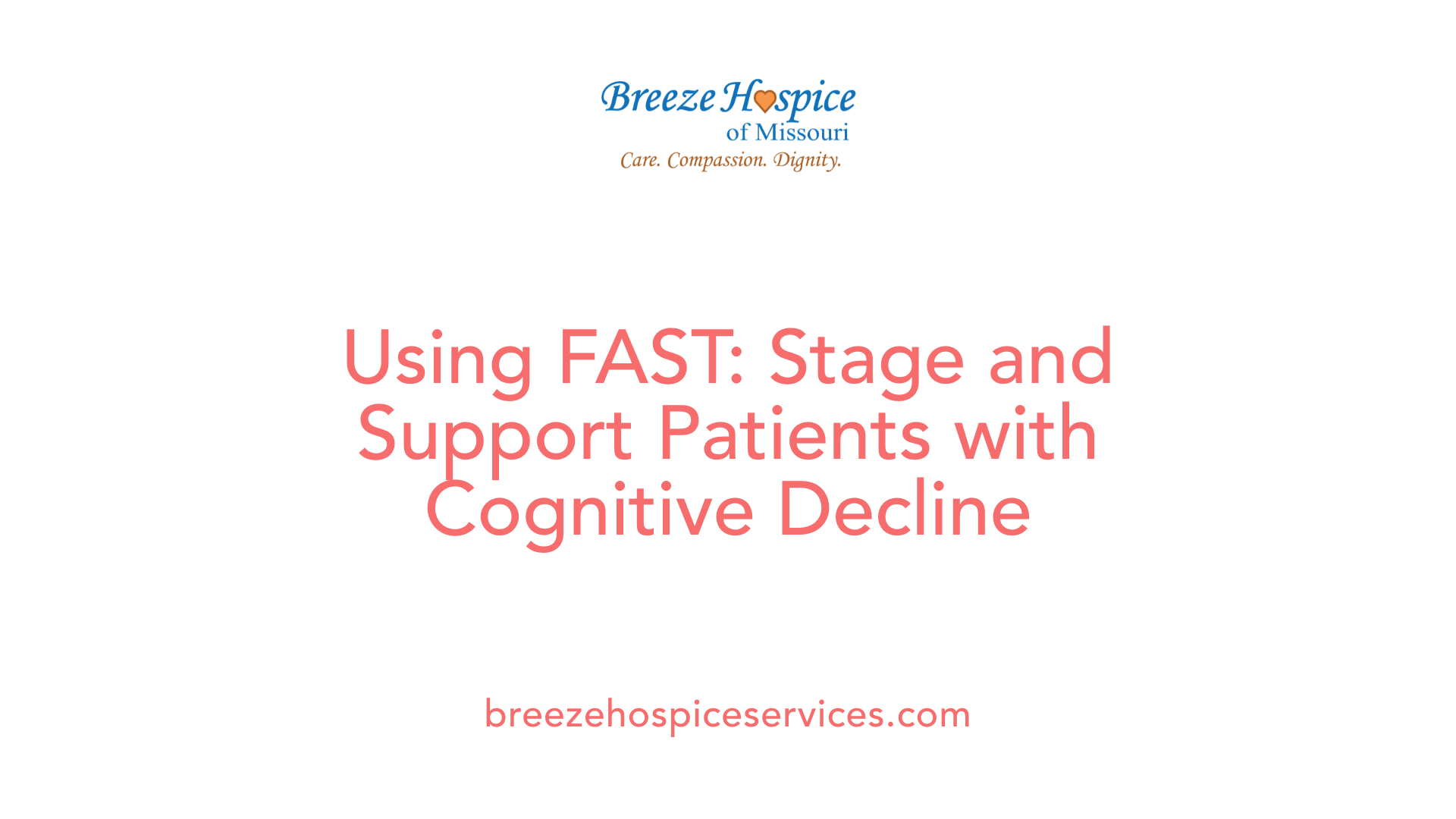
Overview of the FAST tool and staging
The FAST (Functional Assessment Staging Tool) is a well-established instrument used to evaluate and categorize the progression of dementia, especially in its advanced stages. It offers a systematic way to assess cognitive decline and functional abilities, helping clinicians determine the current level of dementia severity. The scale ranges from stage 1, where no detectable impairment, to stage 7, representing very severe cognitive and functional decline.
Range of scores and what they indicate
The FAST scoring system spans from 1 to 7, with subcategories providing detailed insights into each stage.
| FAST Score | Description | Typical Patient Condition | Implications for Care |
|---|---|---|---|
| 1 | No decline | Normal aging | Routine monitoring |
| 2 | Subjective forgetfulness | Mild memory issues | Preventive strategies |
| 3 | Early dementia | Noticeable but manageable changes | Prepare for future planning |
| 4 | Moderate dementia | Assistance needed with complex tasks | Increased care and support |
| 5 | Moderately severe | Need for assistance with daily activities | Enhanced support, planning for functional decline |
| 6 | Severe dementia | Significant dependence | Intensive caregiving, safety measures |
| 7 | Very severe dementia | End-stage, limited communication | Hospice eligibility, comfort-focused care |
A score of 7A or higher usually indicates a very advanced stage, often aligning with the end-stage or very severe dementia that requires extensive assistance.
Application in hospice eligibility and care planning
Hospice programs frequently use the FAST score to assess eligibility for end-of-life care. A FAST score of 7A or above suggests profound cognitive and functional deterioration, signifying that the patient is generally in the final stages of dementia.
This assessment guides not only eligibility determinations but also care planning. It helps healthcare teams tailor interventions to maximize comfort, symptom management, and dignity during the last phase of life. Regular use of the FAST scale enables clinicians to monitor disease progression accurately, facilitating timely adjustments to care plans.
How cognitive impairment impacts decision-making and care planning
Cognitive impairment can substantially influence decision-making and care planning in hospice patients by reducing their understanding, reasoning, and ability to communicate preferences. Many individuals with advanced illnesses have undetected or subtle cognitive deficits that can hinder meaningful participation in treatment choices.
Verbal abilities and overall cognitive function are reliable indicators of decision-making capacity. Assessing these skills is critical for ensuring that patients' wishes are understood and respected. When cognitive impairment is present, family members or appointed proxies often become vital in guiding care in alignment with the patient's values.
Therefore, routine cognitive evaluations—including tools like the FAST score—are essential components of comprehensive hospice care. They ensure that decisions are made with full awareness of the patient's abilities and help in designing appropriate support structures that uphold dignity and comfort.
Progression and Staging—Understanding the FAST tool
What are some examples of severe cognitive impairment?
Severe cognitive impairment involves extensive deficits that profoundly impact an individual's ability to function independently. Common examples include conditions such as Alzheimer’s disease, Lewy body dementia, Parkinson’s disease, Huntington’s disease, stroke-related dementia, traumatic brain injury, and prion diseases. These conditions are marked by significant challenges across multiple cognitive areas, including memory, reasoning, language, visuospatial skills, and judgment.
Individuals at this stage often cannot recognize loved ones, experience substantial memory loss, and struggle with disorientation. Communication difficulties are common, making understanding and expressing needs challenging.
In terms of daily functioning, such individuals typically require comprehensive supervision to maintain safety and well-being. They are often unable to live independently and need specialized care to support their quality of life.
Understanding the progression of dementia through tools like the FAST (Functional Assessment Staging Tool) helps healthcare providers evaluate the severity of cognitive decline and determine appropriate interventions, including hospice care support.
Implications of Cognitive Decline for Care and Decision-Making
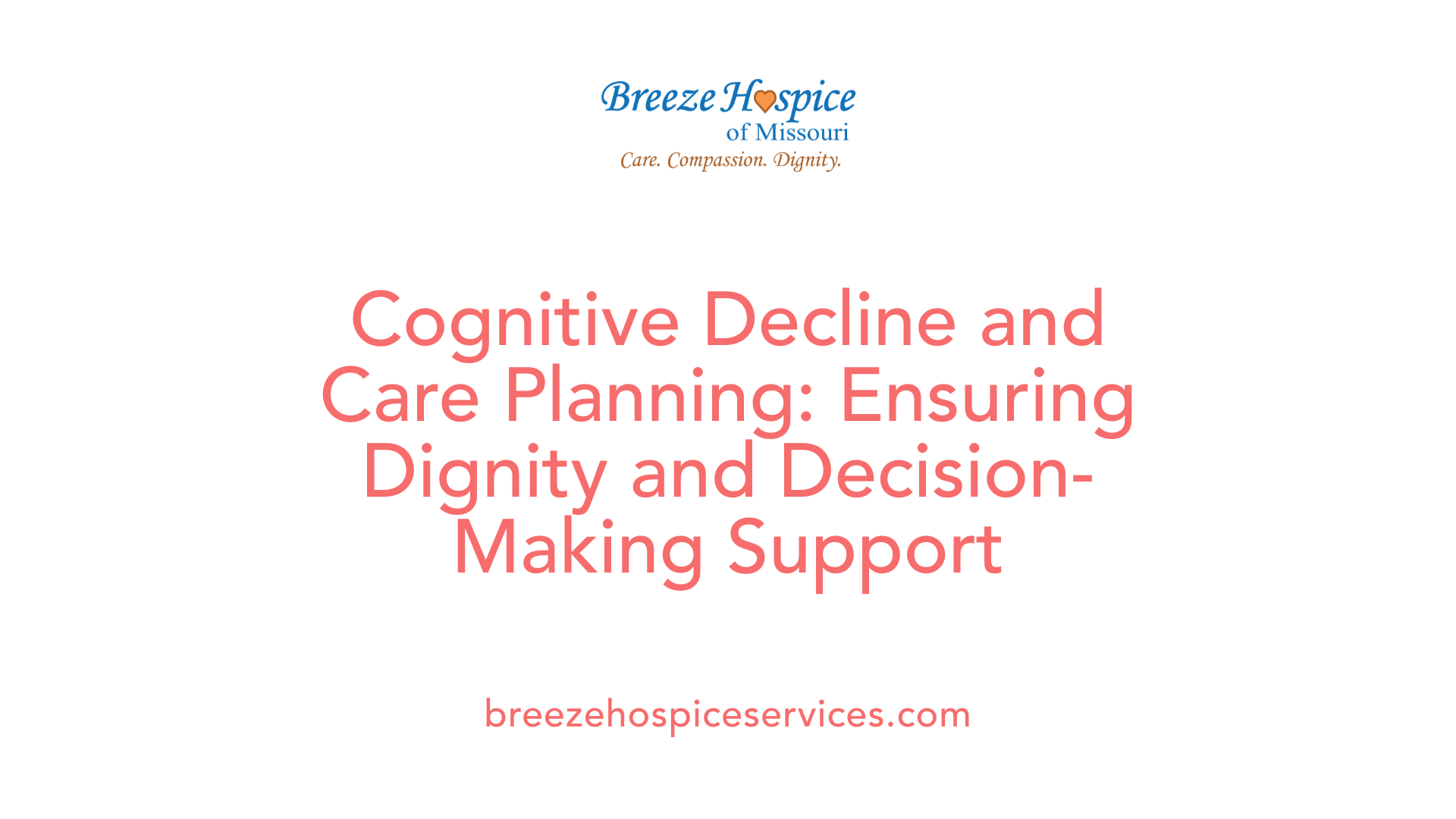
How can cognitive impairments impact a patient’s ability to make decisions?
Cognitive deficits, which are surprisingly common among hospice patients, can significantly diminish decision-making capacity. Impairments in verbal learning, memory, reasoning, and fluency may hinder a patient's understanding of their condition, appreciation of treatment options, reasoning processes, and ability to express choices clearly.
Research shows that even in patients who appear clinically normal, unseen cognitive deficits can undermine their capacity to make informed decisions about their care. This underscores the importance of routine cognitive assessments to accurately gauge decision-making ability.
What role do family members and surrogates play?
When patients struggle with decision-making due to cognitive decline, families and designated surrogates become vital. They often help interpret the patient's wishes and assist in making healthcare choices that align with the patient's values. Proper communication and shared decision-making are essential, especially when patient's cognitive status is compromised.
How can healthcare providers adapt communication strategies?
Effective communication with cognitively impaired patients requires specific approaches. Providers should use simple and clear language, addressing the patient directly and one idea at a time to avoid confusion.
Utilizing visual aids, written checklists, and visual cues can help reinforce understanding. It’s helpful to involve caregivers in the communication process and create a calm, supportive environment to reduce anxiety.
Assessing comprehension regularly and adjusting communication techniques accordingly ensures the patient remains engaged and informed.
Considering sensory impairments, such as hearing or visual difficulties, and respecting cultural or language differences further improves interactions. Tailoring communication strategies in this way supports autonomy and helps ensure that patients' preferences are respected, even when their cognitive abilities decline.
Management Strategies to Support Cognitive and Emotional Well-Being
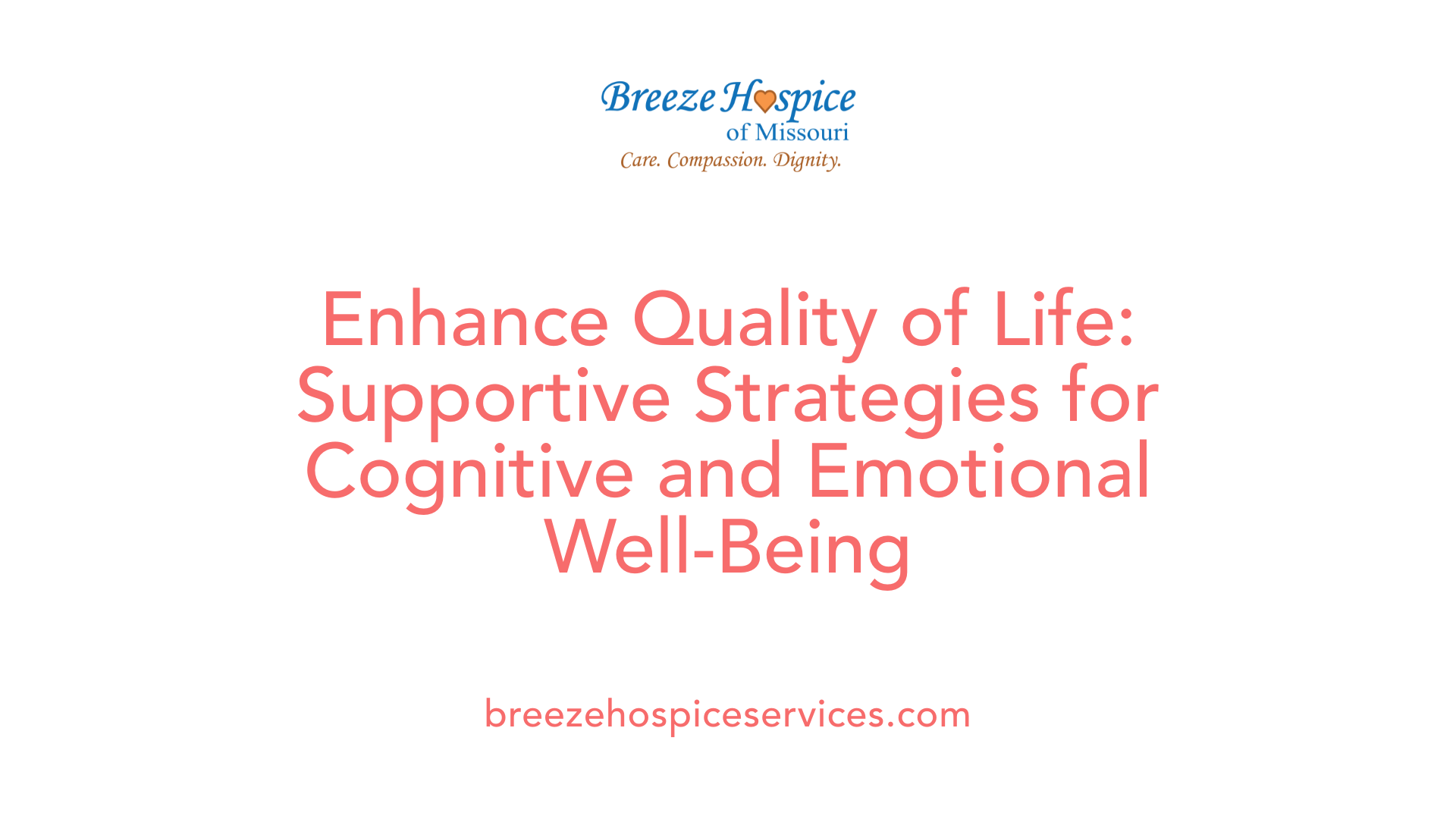
What are some effective management strategies for cognitive impairments in hospice and palliative care?
Addressing cognitive impairments in hospice settings involves a comprehensive approach that emphasizes supportive, non-pharmacological interventions. These strategies focus on maintaining the highest possible quality of life by engaging both the mind and body.
Psychosocial interventions, such as reminiscence therapy and promoting social engagement, are integral. Reminiscence therapy encourages patients to recall past experiences, which can enhance mood and cognitive connection. Social activities not only stimulate mental processes but also provide emotional comfort and reduce feelings of isolation.
Cognitive stimulation activities, including reading, music therapy, and memory exercises, can help sustain existing cognitive skills. These activities are often adapted to individual preferences and abilities, fostering a sense of participation and purpose.
Physical and cognitive activities play a complementary role. Gentle exercises like walking or stretching can support brain health by improving circulation and overall well-being. Combining physical activity with mental exercises enhances resilience against further decline.
Personalized care plans are vital. Tailoring interventions to the individual's cognitive, emotional, and social needs ensures more effective support. Involvement of a multidisciplinary team—including healthcare providers, social workers, and therapists—enables coordinated efforts to address complex needs.
Regular assessment of cognitive status allows for timely adjustments to care strategies. This ongoing evaluation helps identify signs of progression and guides appropriate interventions, whether they involve introducing new activities or modifying existing ones.
In summary, fostering a supportive environment through psychosocial activities, physical stimulation, personalized planning, and team collaboration forms the backbone of managing cognitive impairments. Such an approach not only helps preserve functional abilities but also promotes dignity and comfort for hospice patients.
Potential Interventions and Approaches for Cognitive Enhancement
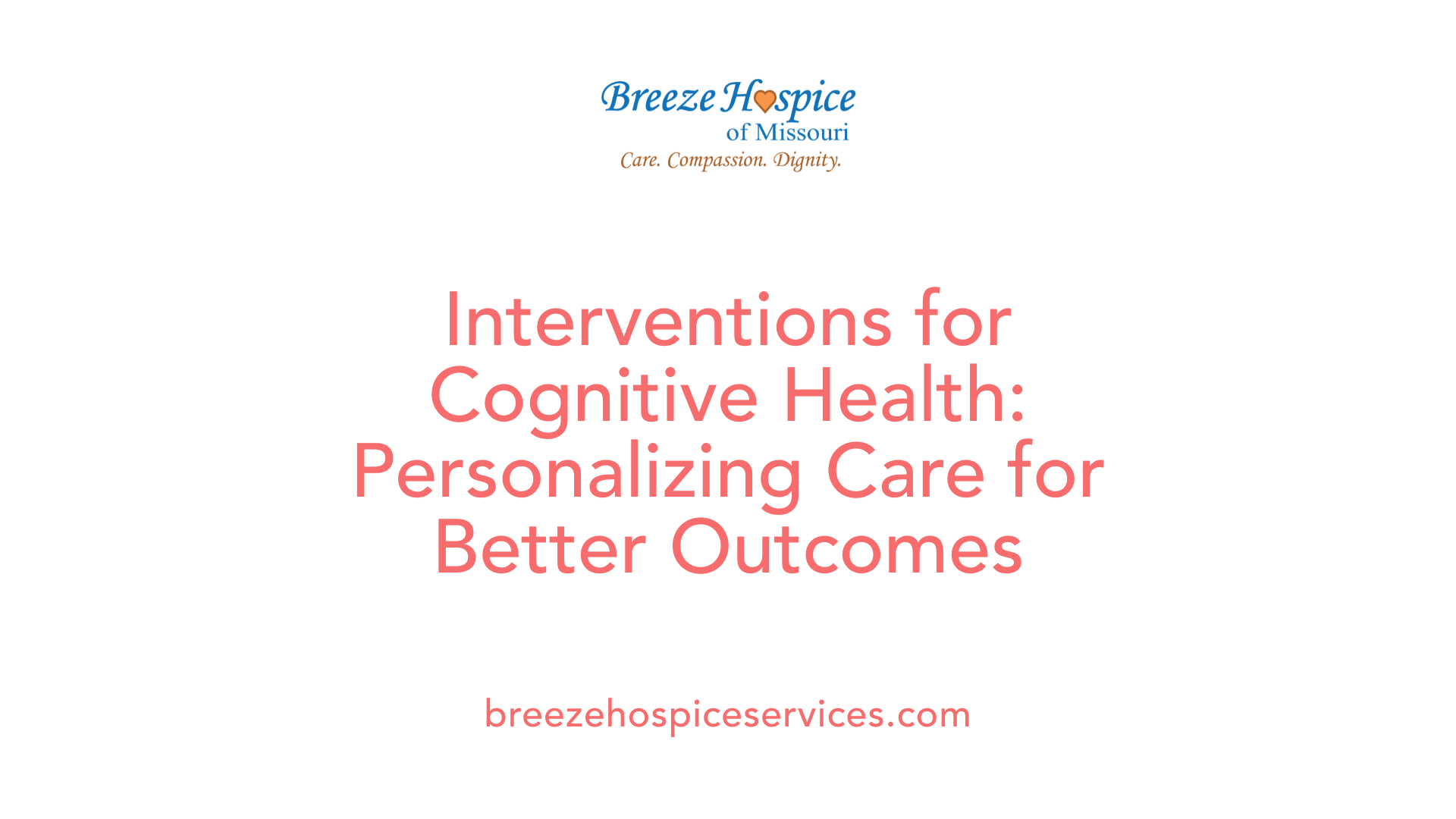
What are some potential interventions for cognitive impairment?
Addressing cognitive impairment requires a comprehensive approach that includes various strategies tailored to individual needs. Physical activities are fundamental, as they promote brain health and neuroplasticity, which can help preserve and potentially improve cognitive functions.
Engagement in arts-based activities offers stimulating experiences for the brain. Participatory activities like ceramic painting, theater, and music encourage active involvement, while receptive activities such as museum visits and theater outings stimulate neural networks and aid cognitive maintenance.
Reminiscence therapy involves encouraging patients to recall personal memories, which can enhance both memory and emotional well-being. This personalized approach helps reinforce existing cognitive skills and fosters a sense of identity.
Psychosocial activities and sensory-based practices are vital in addressing unmet needs that may cause or stem from behavioral and psychological symptoms. These interventions help manage symptoms and improve quality of life.
Person-centered care emphasizes understanding each patient’s unique preferences, history, and values. Strategies focused on dignity and respect can lead to better engagement and response to care.
Social engagement and leisure activities also play a crucial role. Participating in group outings, hobby groups, or social clubs involving cognitive, physical, and social interactions can delay cognitive decline and build cognitive reserves.
In summary, the most effective management involves a combination of these interventions, creating a personalized, multifaceted plan that supports cognitive health and overall well-being.
| Intervention Type | Description | Benefits |
|---|---|---|
| Physical activity | Exercise routines promoting brain circulation | Enhances neuroplasticity and cognitive resilience |
| Arts and leisure activities | Active (crafts, theater), receptive (museum visits) | Stimulates neural pathways, improves mood |
| Reminiscence therapy | Guided recall of personal memories | Strengthens memory, emotional well-being |
| Psychosocial and sensory activities | Customized activities addressing individual needs | Reduces behavioral symptoms, alleviates distress |
| Person-centered strategies | Care tailored to personal preferences and history | Maintains dignity, improves cooperation |
Understanding and applying a diverse array of interventions can significantly impact cognitive health, especially for individuals in hospice or late-stage care. Combining physical, psychological, social, and artistic approaches provides a comprehensive pathway to supporting these individuals.
The Importance of a Multidisciplinary Approach in Managing Cognitive Decline
Managing cognitive decline in hospice patients requires a collaborative effort from a team of healthcare professionals, including physicians, therapists, and social workers. This team works together to assess, monitor, and address the multifaceted aspects of cognitive health.
Physicians play a crucial role in conducting initial screenings and diagnosing potential causes of cognitive impairment using brief tools like the Mini-Cog or QDRS. When necessary, they refer patients for advanced evaluations such as neuropsychological testing, neuroimaging, or specialist consultations to confirm diagnoses like Alzheimer’s disease, Lewy body dementia, or vascular dementia.
Therapists, including neuropsychologists and occupational therapists, help in developing personalized interventions. They can suggest cognitive stimulation activities, adaptive strategies for daily living, and safety modifications to support independence and quality of life.
Social workers contribute by providing emotional support, facilitating communication between the patient, family, and healthcare team, and connecting families with resources and services. They also assist in planning for long-term care needs and caregiver support.
Assessment of cognition, especially verbal abilities such as learning, memory, reasoning, and fluency, guides decision-making capacity evaluations. These skills are vital predictors of a patient’s ability to understand information and express choices, which are essential for informed consent.
A team-based approach ensures that cognitive, behavioral, and functional changes are monitored regularly. It also allows for tailored interventions that address each patient’s unique needs, promoting dignity and comfort in advanced stages.
Effective management relies on clear communication, regular assessment, and coordinated care planning involving patients and their families. This comprehensive strategy is especially important as cognitive impairments often go unnoticed but significantly impact decision-making and quality of life.
| Professional Role | Primary Focus | Assessment Tools & Interventions | Additional Support |
|---|---|---|---|
| Physicians | Diagnosis, medical management | Cognitive screening tools, neuroimaging, specialist referrals | Medical treatment, prognosis, end-of-life planning |
| Therapists (Occupational, Neuropsychologists) | Cognitive therapies, safety, daily functioning | Cognitive stimulation, safety assessments, adaptive strategies | Enhancing independence and quality of life |
| Social Workers | Emotional support, resource linkage, caregiver assistance | Family counseling, resource management, care coordination | Support for caregivers, long-term planning |
Summary and Future Directions in Cognitive Care at End of Life
What are current research areas and best practices for addressing cognitive impairments?
Recent advancements in understanding and managing cognitive deficits among hospice patients have emphasized the importance of early detection, comprehensive assessment, and tailored care strategies. Current research is exploring sophisticated assessment tools like the FAST (Functional Assessment Staging Tool), which stages dementia severity from mild to end-stage. These tools help clinicians identify the level of cognitive and functional decline accurately.
Innovative interventions, including neuroplasticity-based therapies, genetic testing, and biomarkers, are being studied to develop targeted treatments. These approaches aim to slow disease progression, improve quality of life, and retain patient independence for longer periods.
In clinical practice, routine cognitive screening using brief, efficient assessment tools such as the Mini-Cog, AD8, and QDRS has become standard, often taking less than ten minutes. These screenings are vital for making informed decisions about care and eligibility for hospice services, especially in patients with no obvious symptoms but significant underlying deficits.
Best practices include creating individualized care plans based on assessment outcomes, involving a multidisciplinary team that combines psychosocial, physical, and cognitive therapies. Such approaches not only address the physical and emotional needs of patients but also support decision-making capacity and maintain dignity.
Ongoing research into dementia progression and neurodegenerative diseases guides how clinicians tailor interventions for different types of dementias—Alzheimer’s, vascular, Lewy body, frontotemporal, or mixed. These insights assist in planning appropriate palliative care, symptom management, and caregiver support, ensuring each patient receives care aligned with their specific condition.
Furthermore, translating research findings into scalable, practical protocols remains a vital goal. Continued efforts aim at developing clinical guidelines that incorporate the latest scientific knowledge to optimize quality of life and comfort as patients approach the end of life.
How is early detection and ongoing management shaping hospice care?
Detecting cognitive impairments early in the disease course allows for timely intervention, which can significantly modify disease trajectory and care needs. Early assessment can also alleviate concerns if results are negative or help identify treatable reversible causes such as medication effects, infections, or metabolic disturbances.
Once identified, ongoing management focuses on symptom control, safety, and supporting decision-making capacity. Regular reassessment ensures that care plans adapt to the patient’s evolving condition, enhancing their comfort and dignity.
How are care models evolving to meet the needs of patients with cognitive impairments?
Care models are increasingly personalized, emphasizing multidisciplinary collaboration and integration of psychosocial and medical expertise. Training healthcare staff in recognizing early signs of cognitive decline and conducting brief assessments is essential for timely intervention.
In addition, the use of validated staging tools like FAST helps determine when patients reach the advanced or end-stage, guiding hospice eligibility and care focus. As dementia progresses, care shifts toward comfort, symptom management, and supporting the family.
This evolving approach ensures that hospice services remain responsive, patient-centered, and capable of managing complex cognitive and behavioral challenges, ultimately enhancing the quality of life for individuals at the end of their journey.
Toward Compassionate and Informed End-of-Life Care
Effectively addressing cognitive impairments in hospice patients is essential for ensuring dignity, safety, and quality of life. Recognizing that significant cognitive deficits often remain hidden underscores the importance of routine assessment and early intervention. Utilizing tools like the Mini-Cog, AD8, and the FAST score allows clinicians to stage and monitor cognitive decline, informing tailored care strategies. Incorporating psychosocial therapies, lifestyle modifications, and family involvement creates a holistic approach that supports both patient and caregiver well-being. Ongoing research continues to refine these practices, emphasizing early detection, multidisciplinary collaboration, and person-centered care. As hospice teams adapt to the complexities of cognitive decline, they can foster compassionate, informed environments where patients maintain their dignity and comfort at the end of life.
References
- Undetected Cognitive Impairment and Decision-Making Capacity in ...
- Assessing Cognitive Impairment in Older Patients
- Understanding Dementia Progression, Hospice Eligibility, and the ...
- Caring for Older Patients With Cognitive Impairment
- Assessing Cognitive Impairment in Older Patients
- Health care professionals information | National Institute on Aging
- Cognitive Health and Older Adults | National Institute on Aging



































































































